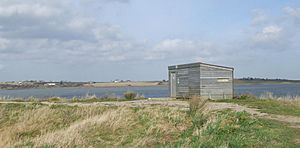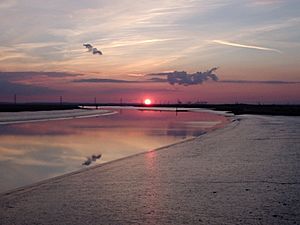The Swale facts for kids
| Site of Special Scientific Interest | |
 |
|
| Area of Search | Kent |
|---|---|
| Interest | Biological |
| Area | 6,509.4 hectares (16,085 acres) |
| Notification | 1990 |
| Location map | Magic Map |
|
Designations
|
|
| Official name: The Swale | |
| Designated: | 17 July 1985 |
|---|---|
| Reference #: | 299 |
The Swale is a tidal channel of the Thames estuary that separates the Isle of Sheppey from the rest of Kent. On its banks is a 6,509.4-hectare (16,085-acre) biological Site of Special Scientific Interest which stretches from Sittingbourne to Whitstable in Kent. It is also a Ramsar internationally important wetland site and a Special Protection Area under the European Union Directive on the Conservation of Wild Birds. Parts of it are a Nature Conservation Review site, Grade I, National Nature Reserves, a Kent Wildlife Trust nature reserve and a Local Nature Reserve.
History
The name "Swale" is Old English in origin, and is believed to mean "swirling, rushing river", or "rushing water". The Swale was originally part of a river. Prior to the formation of the English Channel in about 6500 BC, the eastern coast of Great Britain extended much further into the area of the present-day North Sea, and the Isle of Sheppey formed part of mainland Britain. The channel now occupied by the Swale comprised a river valley facing eastwards. As sea-levels rose, water occupied the whole length of the valley, dividing today's Isle of Sheppey from the mainland.
When the Romans arrived in Britain, the Swale was much wider than it is today, with one part of the Isle of Sheppey — now called the Isle of Harty — a separate island. Two ferry services also crossed the Swale, one between Oare and Harty, and the other between Murston (near Sittingbourne) and Elmley (another former hamlet on the Isle of Sheppey). The Isle of Harty is no longer separate but the marshlands now gradually filling the channel delineate it. The channel needs constant dredging to allow use of the busy waterway.
The Swale is crossed at its western end by two bridges: the Kingsferry Bridge and the later Sheppey Crossing.
Nature

The Swale forms both a National Nature Reserve and a Special Protection Area: the eel grass, Ray's knotgrass, white seakale, glassworts and golden samphire support rare and uncommon migrant butterflies and moths, including the Essex emerald, the ground lackey, the clouded yellow butterfly and rare hawk-moths. Since 1968, it has also been a Site of Special Scientific Interest.
Birds
The Swale provides habitats for the following birds:
- Avocet (Recurvirostra avosetta) at least 17 percent of Great Britain's breeding population
- Marsh harrier (Circus aeruginosus) at least 15 percent of Great Britain's breeding population
- Mediterranean gull (Larus melanocephalus)
- Bar-tailed godwit (Limosa lapponica)
- Eurasian golden plover (Pluvialis apricaria)
- Hen harrier (Circus cyaneus)
- Ringed plover (Charadrius hiaticula)
- Black-tailed godwit (Limosa limosa islandica)
- Grey plover (Pluvialis squatarola)
- knot (Calidris canutus)
- pintail (Anas acuta)
- Common redshank (Tringa totanus)
- Shoveller (Anas clypeata)



